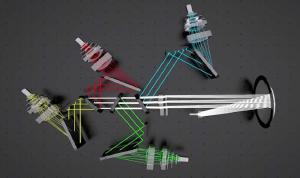Blog
A Tale of Two Computers
28 April 2018
 N.A. Sharp, NOAO/NSO/Kitt Peak FTS/AURA/NSF
N.A. Sharp, NOAO/NSO/Kitt Peak FTS/AURA/NSFIn the early 1900s an astronomer named Annie Jump Cannon set out to catalogue the stars. Because she was a woman, she wasn’t considered an astronomer, but a computer. Part of a team of women astronomers who went though massive piles of photographic data. Computers did the heavy lifting of data mining and analysis.
Cannon’s speciality was identifying atomic line spectra in starlight. By passing starlight through a prism, the light could be spread out into a rainbow of colors. Rather than a smooth rainbow, starlight rainbows have dark gaps known as absorption lines. These absorption lines are caused by cooler gas in the upper surface of a star, which absorbs some of the light. Since each type of element on the periodic table absorbs different colors, the pattern of absorption lines lets us identify the elements that are in the star. It can be difficult to identify those patterns, but over the years Annie Jump Cannon got very good at it. She could identify the absorption lines of a star in about a second.
Looking at thousands of stars, Cannon developed a method to catalog stars using a set of absorption lines known as the Balmer series. Unlike other methods to catalog stars, Cannon’s was clear and easily measured. It also separated stars by their temperature and color, since the Balmer series is affected by temperature. Cannon’s method is so effective that it allowed us to understand the basic evolution of stars. It remains the catalog method we use today.
With the rise of electronic computers, cataloging stars is highly automated, but there are still challenges to overcome. One is to identify stars with a common origin. We know that stars form in large groups known as stellar nurseries. Our Sun was formed within a stellar nursery, and so there must be stars out there that are its siblings. These stars would be made of the same types of elements as our Sun, since they formed from the same cloud of matter. But even with with same elements, the spectra of a large and bright star is different than a cool dim star. Annie Jump Cannon was able to identify stars by focusing on a few easy to observe lines. Identifying common lines among thousands of stars can’t be done by hand. But it could be done by software.
This is where another computer named Cannon comes in. Recently a team of astronomers created a program to identify line spectra in thousands of stars. They named it Cannon after the original Annie Jump, and trained it with data the astronomers had identified by hand. Eventually the program could identify line spectra all by itself. The goal of the program is to identify stars that are related to each other. What you might call the family history of the stars. They’ve recently released their first results.1
Buder et al. “2018a: The GALAH Survey: Second Data Release” arXiv:1804.06041 [astro-ph.SR] (2018) ↩︎